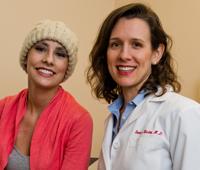Imagine being 22 and having your two biggest fears come true: You have cancer, and your treatment may leave you unable to have children in the future.
While you’re still coming to terms with the diagnosis, you now have to make some major life decisions. Do you want to freeze your eggs? Or should you choose a sperm donor and freeze fertilized eggs instead? Don’t forget to consider your husband’s feelings — even though he isn’t even in your life yet.
“It was so overwhelming,” says Arieana Carcieri, who found herself facing this scenario last year after being diagnosed with Hodgkin lymphoma. “I come from a big family and always wanted at least three kids. The cancer diagnosis alone was all-consuming — I didn’t anticipate the decisions I’d have to make about a future family.”

Arieana turned to Dr. Sara Barton, a fertility specialist at Brigham and Women’s Hospital who collaborates with Dana-Farber/Boston Children’s Cancer and Blood Disorders Center. Dr. Barton sees many young women between the ages of 16 and 21 who are preparing for cancer treatment.
“These aren’t issues women typically think about in their early 20s, especially without a partner,” she said. “We’re asking them to make very mature, complicated decisions that are going to have a big impact on their life trajectory. A lot of girls think yes, I want kids, I want to do it. But then we have to talk about the reality of the situation and the financial cost.”
Cancer treatment can increase the rate at which a woman’s supply of eggs is depleted. Some chemotherapy accelerates the aging of a 20-something’s ovaries to that of a 35- or 40-year-old. Radiation can damage both the ovaries and the cells the uterus needs to regenerate each month, which are important to carry a healthy pregnancy.
Stem cell transplants are probably the most destructive, since intense doses of chemotherapy and radiation often cause sterilization.
Young women faced with these challenges do have options. They may choose to freeze their eggs, depending on the number of eggs harvested — an approach that new results suggest can be an effective way to preserve fertility. A second option, fertilizing eggs with donor sperm, has traditionally been more successful.
But banking is not always an option, particularly for children who start treatment before puberty and don’t yet have mature eggs to freeze. There are alternatives: ovarian tissue preservation for girls and testicular tissue preservation for boys. This approach involves surgical removal of part of the ovary or testes and freezing the tissue that contains eggs — a procedure that has led to successful births, but only very recently and data is very limited.
Barton says there is hope that these techniques will provide a reliable option for girls and boys who cannot freeze eggs or sperm because of age or lack of time to harvest eggs, which can take about two weeks.
“When we’re talking to the parents of young girls, we explain that this option is really an insurance policy, and at the present time, a leap of faith,” Barton said.
“You have to believe that in the time it takes for your daughter to grow up — which in some cases is 20 years or more — the science will catch up. For some people, that’s enough.”
Complicating any decision are the costs associated with fertility preservation. Barton says it’s about $5,000 to freeze eggs, and that doesn’t include the annual storage fee of $400 — expenses that aren’t covered by insurance companies, since the procedure is still considered experimental.
Egg freezing presents additional challenges too. It involves daily injections, many doctor visits and ultrasounds, and a very sensitive procedure.
“It was easy for me to say that this was something that I wanted to do. I would be so worried about having children otherwise,” Arieana said. “But there was a lot of information I had to understand first. Dr. Barton spent hours with me going through the pros and cons of each choice.”
Arieana opted for IVF treatment and had 23 eggs removed. She chose a sperm donor to fertilize half and — in case she has a husband one day — froze the other half as unfertilized eggs.
If and when she chooses, she will have at least a few attempts at a healthy pregnancy. And while the procedure was expensive, she was able to get help from Fertile Hope, a nonprofit that provides financial assistance to cancer patients at risk for infertility.
But Arieana has many things she would like to accomplish before she starts a family. She finished treatment in February and is looking forward to the New York City Triathlon in July. She also plans to begin classes when she’s feeling better, although she now has a new career path.
Inspired by her care team, Arieana hopes to become a nurse.

Great article! Wi too received treatment for Hodgkin’s Lymphoma at the Farber in 2006 at the age of 33. Although my daughter wad 14 months old, it was my dream to have another child. Dr. Jennifer Brown hflped me through all of my options. In 2009, I gave birth to my son Niccolo’!